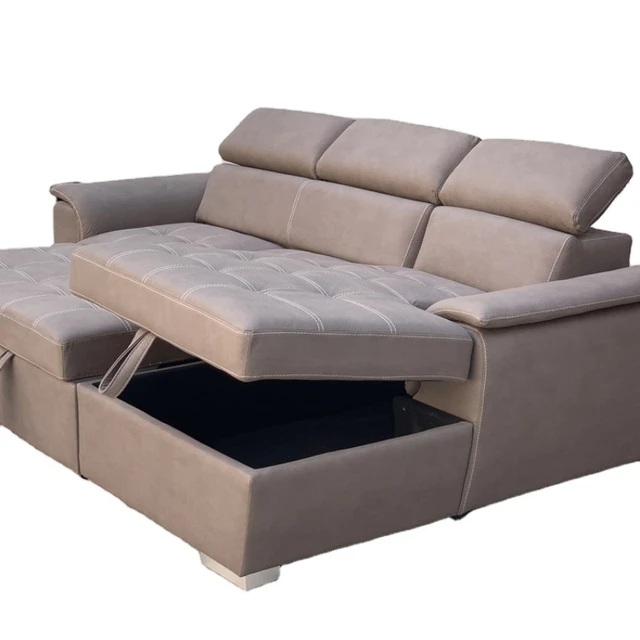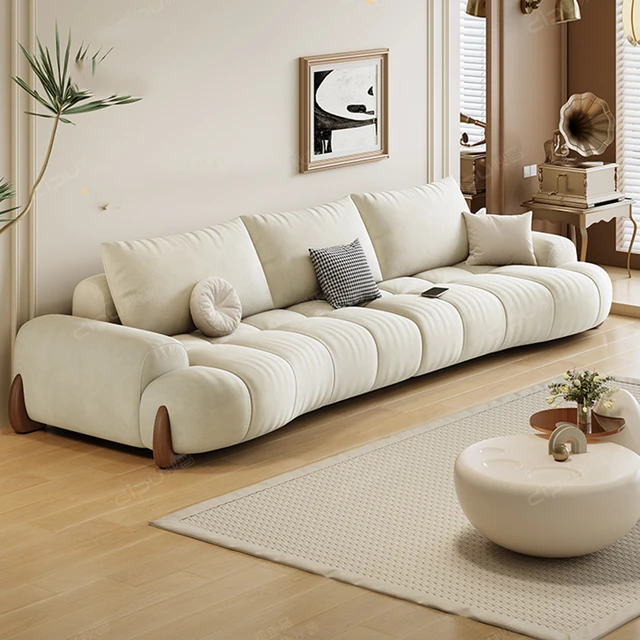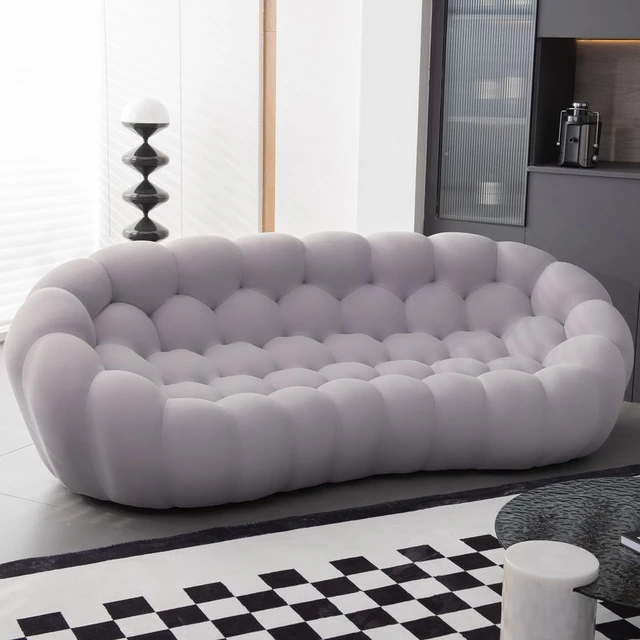 Introduction:
Introduction:
The height of a sofa plays an essential role in comfort and overall aesthetics. Choosing the right sofa height can significantly impact the functionality and style of a living space. In this comprehensive guide, we will explore the standard sofa height and its importance. By understanding the factors that influence sofa height and considering your specific needs, you can find the perfect fit for your home and create a comfortable and visually appealing seating area.
 Here are some common types of sofas:
Here are some common types of sofas:
There are several types of sofas available, each with its own distinct design, features, and characteristics. Here are some common types of sofas:
Traditional Sofa:
Traditional sofas feature classic design elements, such as rolled arms, tufted backs, and decorative wood details. They have a timeless and formal appearance, often upholstered in rich fabrics like velvet or leather.
Sectional Sofa:
Sectional sofas consist of multiple sections or pieces that can be arranged in various configurations to fit different room layouts. They offer ample seating space and are popular for creating a cozy and comfortable seating area in larger living rooms.
Chesterfield Sofa:
A Chesterfield sofa is known for its distinctive deep button-tufting, high rolled arms, and backrest of the same height. It exudes elegance and sophistication and is often made of leather.
Sleeper Sofa:
Sleeper sofas, also known as sofa beds or pull-out sofas, serve a dual purpose by providing both seating and a guest bed. These sofas typically have a fold-out mattress stored under the seat cushions for convenient overnight accommodations.
Loveseat:
Loveseats are smaller sofas designed to seat two people comfortably. They are suitable for smaller living spaces or to complement a larger sofa in a seating arrangement. Loveseats come in various styles and can be upholstered or leather.
Modular Sofa:
Modular sofas consist of individual seating units that can be rearranged and combined to create a customized seating arrangement. They offer flexibility and versatility in design, allowing users to adapt the sofa layout to their needs.
Mid-century Modern Sofa:
Mid-century modern sofas feature clean lines, simplicity, and organic shapes inspired by the mid-20th century design movement. They often have low profiles and can be upholstered in colorful, textured fabrics or feature exposed wooden frames.
Reclining Sofa:
Reclining sofas have built-in mechanisms that allow the backrest and footrest to recline, providing a comfortable lounging experience. They are ideal for relaxation and are often chosen for home theaters or living rooms focused on comfort.
These are just a few examples of the many types of sofas available. When selecting a sofa, consider factors such as design style, size, comfort, durability, and the overall aesthetic and function needs of your space.
 The Role of Sofa Height
The Role of Sofa Height
Comfort and Ergonomics:
Sofa height directly affects the comfort and ergonomics of seating.
A well-proportioned sofa height ensures that users can sit and stand up comfortably, without straining their back, knees, or hips.
Interaction and Socializing:
The height of a sofa can influence how people interact and socialize in a seating area.
A properly sized sofa allows individuals to maintain eye level and engage in conversations comfortably.
Visual Balance and Aesthetics:
Sofa height plays a vital role in the visual balance and overall aesthetics of a room.
It should align with the height of other furniture pieces and complement the proportions of the surrounding space.
Determining Standard Sofa Height
Industry Standards:
While there are no strict industry standards for sofa height, there are general guidelines that can be followed.
Standard sofa heights often range from 30 inches (76 cm) to 36 inches (91 cm) for a standard back height.
Seat Height Considerations:
Seat height is an essential component of overall sofa height.
Standard seat heights typically range from 17 inches (43 cm) to 19 inches (48 cm) for optimal comfort and accessibility.
Variations in Styles and Designs:
Sofa heights can vary depending on the style and design of the piece.
Modern or low-profile sofas may have lower seat heights, while traditional or high-back sofas may have higher overall heights.
 Factors Influencing Sofa Height
Factors Influencing Sofa Height
User Preference and Body Proportions:
Individual preferences and body proportions play a significant role in determining the ideal sofa height.
Taller individuals may prefer sofas with higher seat heights, while shorter individuals may feel more comfortable with lower seat heights.
Function and Intended Use:
The function and intended use of the sofa should also be considered when determining the appropriate height.
Sofas for lounging and relaxation may have lower seat heights, while sofas for formal or supportive seating may have higher heights.
Room Proportions:
The dimensions and proportions of the room where the sofa will be placed should be taken into account.
A smaller room may benefit from lower-height sofas to maintain a sense of spaciousness, while a larger room can accommodate taller sofas.
Customization and Adjustability
Customizing Sofa Height:
Some furniture manufacturers offer customization options, allowing customers to select preferred seat heights or overall sofa heights.
Customizing the sofa height ensures a perfect fit and addresses individual comfort needs.
Leg Adjustability:
Some sofas come with adjustable legs, allowing for minor height modifications to accommodate different users or preferences.
This feature can be beneficial when multiple individuals with varying needs will be using the sofa.
Here are some general tips and considerations for cleaning a sofa:
When it comes to cleaning a sofa, it’s important to follow proper care instructions and take precautions to avoid damaging the fabric or upholstery. Here are some general tips and considerations for cleaning a sofa:
Read the Care Instructions:
Before cleaning your sofa, check the manufacturer’s care instructions. Different fabrics and upholstery materials may have specific cleaning recommendations that you should follow to avoid damaging the sofa.
Vacuum Regularly:
Regularly vacuuming your sofa helps remove dust, dirt, and crumbs from the surface and crevices. Use a soft brush attachment or a handheld vacuum cleaner to gently clean the upholstery and cushions.
Spot Cleaning:
For small stains or spills, it’s best to address them promptly. Blot the stain gently using a clean cloth or paper towel, being careful not to rub or scrub the stain, as it can spread or damage the fabric. Use a mild detergent or a specialized upholstery cleaner recommended for your sofa’s fabric, following the instructions on the product label.
Test in an Inconspicuous Area:
Before using any cleaning solution or detergent on your sofa, it’s advisable to test it in an inconspicuous area first. Apply a small amount of the cleaning solution to an unseen part of the sofa and check for any adverse reactions or color fading before using it on a more visible area.
Avoid Harsh Chemicals:
Harsh chemicals, such as bleach or ammonia-based cleaners, should be avoided as they can damage or discolor the fabric. Stick to gentle and mild cleaning solutions suitable for your sofa’s fabric type.
Professional Cleaning:
It’s recommended to have your sofa professionally cleaned periodically, especially for deep cleaning or stubborn stains. Professional cleaners have the expertise and appropriate equipment to clean different types of upholstery effectively.
Sunlight and Moisture:
Protect your sofa from prolonged exposure to direct sunlight, as it can fade or discolor the fabric. Likewise, avoid excessive moisture or humidity, as it can promote mold or mildew growth.
Regular Maintenance:
Regularly fluff and rotate the cushions to distribute wear evenly. Use armrest covers or throws to protect the sofa from spills, pet hair, or other potential stains.
By following these tips, you can help keep your sofa clean and prolong its lifespan. When in doubt, consult the manufacturer’s recommendations or seek professional advice for specific cleaning instructions tailored to your sofa’s fabric type.
 Conclusion:
Conclusion:
The height of a sofa directly impacts comfort, ergonomics, and overall aesthetics. While there are no rigid industry standards for sofa height, there are general guidelines that can be followed. Considerations such as comfort, interaction, visual balance, and individual preferences should be taken into account when selecting the ideal sofa height for your space. By understanding these factors and leveraging customization options, you can find a sofa that offers both comfort and visual appeal. Take the time to measure and assess your needs to ensure that the sofa height aligns with your desired level of comfort and complements the overall style of your living area.


